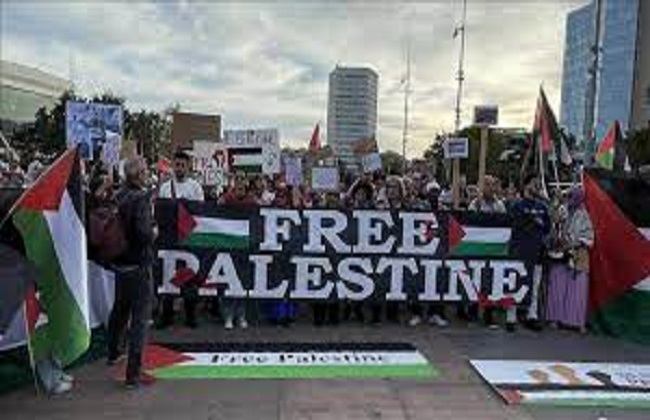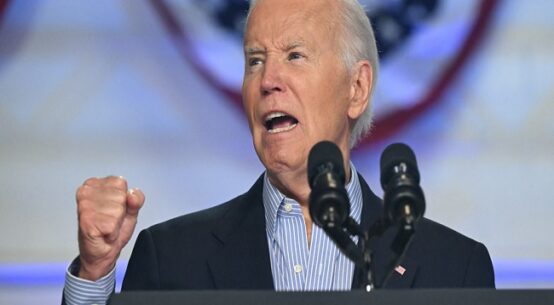
To mark the International Day of Solidarity with the Palestinian people condemning Israel’s war on Gaza, protests were held on Wednesday across the globe, from Tokyo to Manila, Tehran and Beirut, Stockholm and London, and in Harare, Johannesburg, Quezon City, and Milan.
The UN Secretary-General Antonio Guterres termed this year’s International Day of Solidarity to come during “one of the darkest chapters in the history of the Palestinian people.”
With 1.7 million Palestinians suffering a humanitarian catastrophe and having been forced from their homes, he said, “nowhere was safe.” Even the situation in the occupied West Bank, including East Jerusalem, was of grave concern.
Like in other part of the world, in the southern port city of Karachi, with a population of 20 million, the youngest protestor was one-year-old Zaaveel. “
This is how she will learn to show solidarity for the oppressed,” said her mother, Noor-us-Sabah, who carried her in her arms on the 2.5-kilometer walk along with people from all walks of life, including politicians, civil society and religious leaders, rights activists, students, and ordinary people of Karachi.
Noor-us-Sabah was not the only mother with babies. A school teacher, carrying her two-year-old son, Mir Hadi, said: “What’s happening in Palestine is devastating; carrying him in my arms and walking is my way of condoling with all the mothers in Gaza who lost their young ones,” she said.
Holding placards and Palestinian flags and chanting in Urdu “Azad rahey ga falestine, abad rahey ga falestine,” to “From the river to the sea; Palestine will be free,” many marchers were wearing the keffiyeh, a scarf seen as a symbol of Palestinian identity and resistance. There was also a group holding a huge Palestinian flag, 28 by 45 feet long, while walking.
Interestingly, as rallies usually go, there were not many poetic slogans during the walk. It was a deliberate decision, said Umar Farooq, a civil rights activist and one of the organisers. “We kept slogans limited to keep any religious or ideological disagreements out,” he pointed out.
Former Karachi administrator Fahim Zaman, also one of the organisers, told IPS: “Holding the rally had a two-fold purpose: to show solidarity with the Palestinian people and against the Israeli Zionists and the western imperialists, and to form a non-partisan platform where everyone, including all political and religio-political parties, can come together.”
Artist Durriya Kazi said she joined the rally to “honour the efforts of our ancestors, many from my own family, who untiringly protested the illegality of the 1917 Balfour Declaration, the root cause of the conflict in the region over the last 100 years.” The declaration, one of the most controversial and contested documents in the modern history of the Arab world, issued on November 2, 1917, was a pledge by the British to establish a national home for the Jewish people in Palestine.
She also found it encouraging that the political parties came together at a civil society-led rally. “It brought together ordinary citizens and political parties for one cause,” she said. And even though the rally was not huge, “the only flags flying were those of Palestine.”
“The best thing about the rally was seeing different political parties under one flag of Palestine,” said Rana Ansar, a senior political leader belonging to the Muttahida Qaumi Movement and former opposition leader in the Sindh provincial assembly.
A day before, Senator Saeed Ghani, of the Pakistan People’s Party, sent a public message to his part-time workers to join the rally “without party flags,” as the march was not about them but Palestine and its people. The delegate from the Pashtun nationalist political party in Pakistan, the Awami National Party, came wearing their red caps and carried Palestinian flags.
While there is no accurate figure to know how big the rally was, according to Farooq, “the cameramen and reporters who cover rallies and who are more experienced at estimating crowd size told us there were some 25,000–30,000 people.” However, he added more than numbers: “I think people saw a ray of hope in collective action after a long time.”
“It was great to see people from all walks of life, including the elderly, disabled, and children,” said actor Ushna Shah, adding: “As far as rallies go, it was exceptionally well organised and executed.”
“I wanted to demonstrate that Palestinian lives matter and, at the same time, send a strong message to Israel that it needs to stop this lunacy NOW,” said Huma Amir Shah, a popular television presenter, with a keffiyeh around her neck. “Public opinion matters, numbers matter, and hence I joined the march.”
Kazi said the rally was representative of the protest of all Pakistanis who want to stand by Palestinian people, and she wanted to lend her voice to millions across the world who are “horrified by the ruthless massacre by Israeli forces of Palestinian men, women, and children, whose intention seems to be total annihilation of the population and making the land uninhabitable by destroying its infrastructure.”
The Pakistanis, it seems, feel they cannot do enough to ease the pain in Gaza. An unprecedented 2800 doctors and nurses have volunteered their services to treat the injured and the sick in Gaza but are not finding a way to get there.
“I wish someone could raise this issue and bring it to the attention of the international community and Egyptian authorities to let us in,” said 42-year-old orthopaedic surgeon Dr Hafeez-ur-Rehman. “They really need us.”
Over 200 healthcare workers have been killed in Gaza since the start of the conflict, according to the Palestinian Ministry of Health.
Zofreen T. Ebrahim is an independent freelance journalist based in Karachi, Pakistan. She was an editor of the magazine, Woman’s Own and is the current editor for The Third Pole; a platform dedicated to promoting information about the Himalayan watershed and the rivers that originate there.


